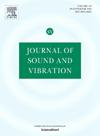Resonant topological metasurface for Rayleigh wave attenuation and energy localization in homogeneous and layered elastic half-spaces
IF 4.3
2区 工程技术
Q1 ACOUSTICS
引用次数: 0
Abstract
In this work, we design a resonant topological metasurface based on the Su-Schrieffer-Heeger model and investigate its energy localization and interaction with Rayleigh waves in both homogeneous and layered elastic half-spaces. To this aim, we establish a general analytical framework using the thin-layer method and multiple scattering theory. This approach allows us to calculate the spatially modulated frequency spectrum, revealing the presence of a topologically nontrivial bandgap (TNBG). Also, eigenfield and flux analyses capture a topologically protected interface mode (TPIM) at the interface between two domains with distinct topological unit cells. Further wave field analysis shows that the TPIM enables significant Rayleigh wave energy localization. Meanwhile, the TNBG exhibits dual attenuation mechanisms of Rayleigh-to-Rayleigh Bragg backscattering and Rayleigh-to-bulk wave conversion, demonstrating a strong wave attenuation capability. In addition, the topological metasurface displays robust performance against half-space stratification, as its topological properties remain unaffected by higher-order Rayleigh modes. It maintains great energy localization and excellent vibration mitigation performance in the layered elastic half-space. This resonant topological metasurface provides a promising new approach for low-frequency Rayleigh wave mitigation and energy harvesting in real foundations.
求助全文
约1分钟内获得全文
求助全文
来源期刊

Journal of Sound and Vibration
工程技术-工程:机械
CiteScore
9.10
自引率
10.60%
发文量
551
审稿时长
69 days
期刊介绍:
The Journal of Sound and Vibration (JSV) is an independent journal devoted to the prompt publication of original papers, both theoretical and experimental, that provide new information on any aspect of sound or vibration. There is an emphasis on fundamental work that has potential for practical application.
JSV was founded and operates on the premise that the subject of sound and vibration requires a journal that publishes papers of a high technical standard across the various subdisciplines, thus facilitating awareness of techniques and discoveries in one area that may be applicable in others.
 求助内容:
求助内容: 应助结果提醒方式:
应助结果提醒方式:


